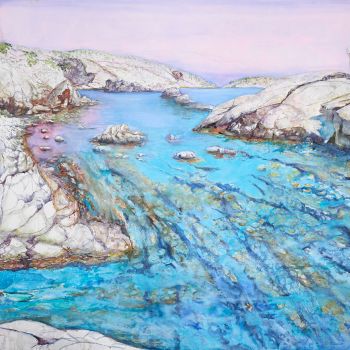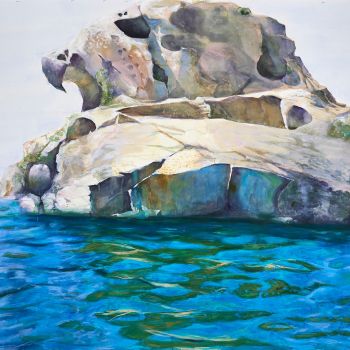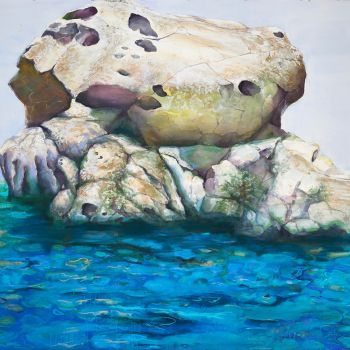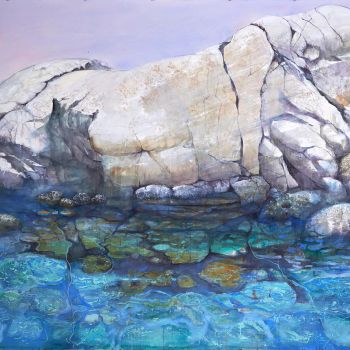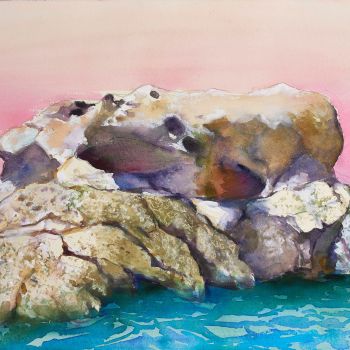A long way from lingering in cafés aglow with crimson where wine glasses are drained and searching glances exchanged; far from children’s frolicking by the seaside under the glare of tropical sun and stretch of cerulean sky – as well as their forays into fairy-tale forests where they stumble upon ‘pagan’ effigies, woodland sprites, watchful fauves. We’re also at a distance from dollhouses, displays of miniature theatre stagecraft and the puppeteer’s sleight of hand. Here with this new body of works painter Irini Iliopoulou has set sail for other parts.
As the artist herself explains, around two years back she felt she needed a change from the years of ‘storytelling’ and decided to work in a more direct manner, which is why she turned to the mineral world. Their fluidity and immediacy makes watercolors an ideal medium for approaching the forever-fluctuating seascape. And she found that while painting rocks in the sea, unsolicited fantastical features emerged – in the same way we can see shapes and figures in cloud formations if we stare at the sky long enough. The current exhibition entitled Mare Mineralis is comprised of 6 large-scale watercolors (2 x 1.5 m) and some 14 other pieces of smaller dimensions. We first glimpsed works from this new series of aquarelles at Art Athina in May 2014 where Iliopoulou exhibited with the Athens Art Gallery. In most of the present paintings, the artist is not contemplating a seascape from the shoreline but instead studying tiny islets at close range and at eye level (as if from a passenger boat), which intensifies the feeling of solitude and quietude.
These works are pared-down to the elemental, almost denuded in comparison to Iliopoulou’s ‘cornucopian’ compositions of lush gardens and groves. Here the soft-hued rock masses are anchored offshore with no beach to be seen anywhere. Are sirens circling underwater only to break the surface when no one’s looking? In some paintings a shallow pool laps at the edge of a boulder and the water is ‘paved’ in a lily-like pattern that recalls Art Nouveau wallpaper motifs. In others, the drop below the rock plunges precipitously and nothing can be made out in the mysterious abyss beneath. More important than fathoming the depths is discerning what is visible on the calm sea surface: a rock outcrop jutting out like an Iguana figurehead; another mound conjures the spread of a walrus’ backside, or the rump of a sphinx. In one seascape picture we find the beak of a falcon. Elsewhere, a lion’s ivory-colored skull sits on a plinth, its hollows eerily shadowed. Then the Loch Ness rears up out of the sea while further on the mammoth hulk of Moby Dick looms up on the steamy white horizon like some midday mirage – reminding us of the immense solitariness of the white whale, with his formidable crest of barnacles. The leviathan, like the Alps, pyramids and cratered face of the moon, in their gargantuan whiteness, evoke the glacial aura of what, in our imagination, is immoveable, eternal. However, this muteness is tempered in some of the other aquarelles by rendering limestone in pale mauve, or veined with red, reminiscent of bone marrow, elsewhere covered in moss and lichen. Sun-bleached, banded, salt-eroded alabaster contrasts with the backdrop of a rose-streaked sunset; rock cavities cast in a yellow hue alongside tartar-colored slabs. Indeed, the diffuse pale light before dusk or the darkening sky that announces a storm, lend a phantasmal glow to the otherwise lusterless rocks; in other paintings the absence of direct light brings out a flush on the rock face (much like the warm translucency of marble.)
Legendary monsters or extinct species, Iliopoulou’s ‘sea creatures’ are the stolid guardians of Poseidon’s kingdom, appearing at intervals along the shoreline and further adrift like coastal signposts, or stations marked on a treasure map. One lonely stone formation with an especially tempestuous background puts us in mind of the doomed ghost ship, the Flying Dutchman; or Jonah, first jettisoned from the boat for bad luck, then swallowed by the whale (to be spat out 3 days later). Totemic stoic sea sculptures crowned with tufts of moss and riddled with cracks and crevices, even streaks of pitch. Is this cave with an awning of seaweed tresses the site of mystical initiation rites or rather the mouth of a pirate cove where the trove is buried? Apart from the rare exception, these scenes of craggy islets are devoid of any human presence although they elicit animal attributions. Weather-worn, sculpted and smoothed by water and wind, white-washed by the sun, these monumental rocks preside over the sea, moored like permanent sentinels; buoys signaling sunken ships or evoking the chimera of mythical Atlantis. Once Irini Iliopoulou’s gaze alights on the stone in the lull of an overcast afternoon, her eye begins sounding craters, pits, holes and seams in search of the hidden, to show how the geologic can suggest something more ambiguous than a plain hard surface.
Andrea Schroth
January 2015


